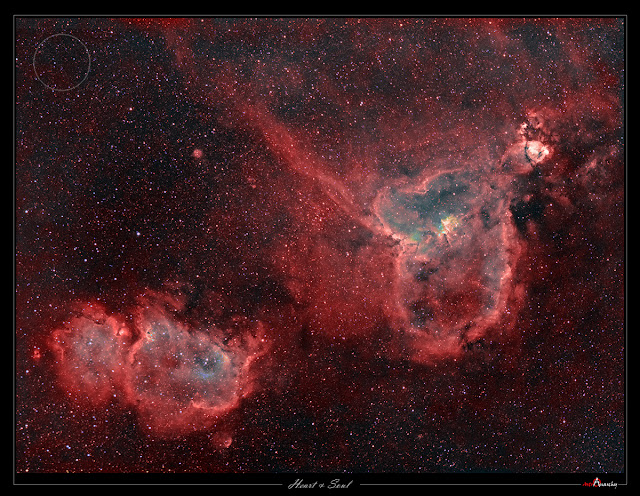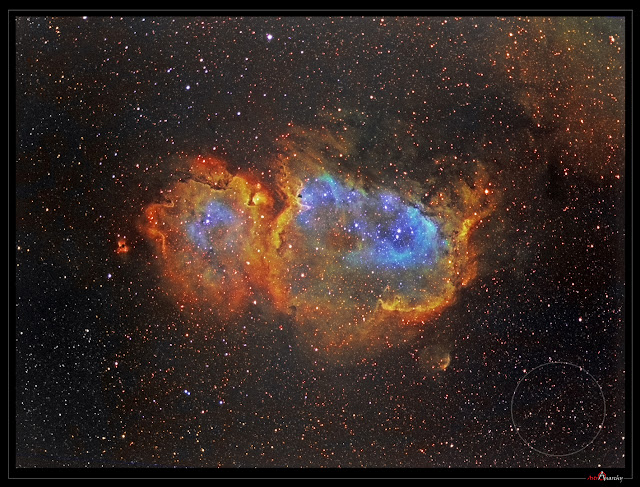COPYRIGHT, PLEASE NOTE
All the material on this website is copyrighted to J-P Metsavainio, if not otherwise stated. Any content on this website may not be reproduced without the author’s permission.
Have a visit in my portfolio
PORTFOLIO:https://astroanarchy.zenfolio.com/
Monday, May 23, 2011
California Nebula, NGC 1499, scale in a sky, zoom in series
I have shot many targets with several focal lengths.
Due that, I will publish some older images as an image sets, with different field of view and detail levels.
The fractal nature of our universe stands out nicely by this way and it will make the orientation more easy.
Many times, it's difficult to understand the image scale of astronomical images.
Due that, I will add a Moon circle in some of the images to show the angular scale in a sky.
The full Moon has an angular size of ~30 arc minutes, that's equal to ~0,5 degrees.
The full Moon
California Nebula, NGC 1499
In constellation Perseus
NOTE. The size of the full Moon (0,5 degrees) is marked as a gray circle in all of the images.
1. Image from 2008, Canon FD 200mm f2.8 camera lens, QHY8 astronomical camera
2. Tokina AT-X 300mm f2.8 camera lens, QHY9 astro camera and a Baader NB-filter set
3. A closeup with the Meade LX200 GPS 12" ~2000mm, QHY9 and a Baader NB-filter set
Original images and technical details
Labels:
Narrowband color images,
nebula
Sunday, May 22, 2011
Rosette Nebula, the scale in a sky, zoom in sereies
I have shot many targets with several focal lengths.
Due that, I will publish some older images as an image sets, with different field of view and detail levels.
The fractal nature of our universe stands out nicely by this way and it will make the orientation more easy.
Many times, it's difficult to understand the image scale of astronomical images.
Due that, I will add a Moon circle in some images to show the angular scale in a sky.
The full Moon has an angular size of ~30 arc minutes in a sky, that's equal to ~0,5 degrees.
"Rosette Nebula"
Ra 06h 33m 45s Dec +04° 59′ 54″
from the emission of ionized elements, R=Sulfur, G=Hydrogen and B=Oxygen.
Star colors are mixed from the NB channels, Red=H-a, G=O-III and B= 85%O-III + 15%H-a.
NOTE. The size of the full Moon (0,5 degrees) is marked as a gray circle in all of the images.
Images from top to bottom
Star colors are mixed from the NB channels, Red=H-a, G=O-III and B= 85%O-III + 15%H-a.
NOTE. The size of the full Moon (0,5 degrees) is marked as a gray circle in all of the images.
Images from top to bottom
1. Two panel mosaic of Cone and Rosette Nebulae. Shot with a Canon EF 200mm f1.8 lens, Baader NB-filters and QHY9 cooled astronomical camera.
2. The Rosette half of the mosaic image.
3. Rosette Nebula with a Tokina AT-X 300mm f2.8 lens, Baader NB-filter set and QHY9 astro camera.
4. Rosette closeup with Meade LX200 GPS 12" 2000mm, NB-filters and QHY9 camera.
Technical details for all of the images above, can be found in my portfolio:
http://astroanarchy.zenfolio.com/
Technical details for all of the images above, can be found in my portfolio:
http://astroanarchy.zenfolio.com/
Saturday, May 21, 2011
Wide field vs closeups, Heart Nebula, IC 1805
I have shot many targets with several focal lengths.
Due that, I will publish some older images as an image sets, with different field of view and detail levels.
The fractal nature of our universe stands out nicely by this way and it will make the orientation more easy.
Many times, it's difficult to understand the image scale of astronomical images.
Due that, I will add a Moon circle in some images to show the angular scale in a sky.
The full Moon has an angular scale of ~30 arc minutes in a sky, that's equal to ~0,5 degrees.
A wide field image of the area
NOTE. The size of the full Moon (0,5 degrees) is marked as a gray circle at upper Left corner.
A wide field image of the area, covering about 5 degrees, ~300', of the sky.
(Ten full Moons side by side)
Two main objects can be seen in the image:
IC 1805, the "Heart Nebula", locates at upper Right.
IC 1848 can be seen at lower Left.
Image is shot with a Canon EF 200mm f1.8 camera lens and a QHY9, a cooled astronomical camera.
Baader narrowband filter set, total exposure time was ~1,5 hours (A very fast lens was used!). Original Blog post can be found HERE.
A zoom in image series of IC 1805, the "Heart Nebula"
In this zoom in series, three images from IC 1805 are taken by using different focal lengths.
A gray circle shows the size of the full Moon, ~30' or ~0,5 degrees.
First image is taken with a focal length 200mm, Canon EF200mm @f1.8
Second image with a SkyWatcher 80ED ~600mm f7.5
Third one with Meade LX200 GPS 12" ~2000mm f6.5
Labels:
Narrowband color images
Wide field vs closeups, Soul Nebula, IC1848
I have shot many targets with several focal lengths.
Due that, I will publish some older images as an image sets, with different field of view and detail levels.
The fractal nature of our universe stands out nicely by this way and it will make the orientation more easy.
Many times, it's difficult to understand the image scale of astronomical images.
Due that, I will add a Moon circle in some images to show the angular scale in a sky.
The full Moon has an angular scale of ~30 arc minutes in a sky, that's equal to ~0,5 degrees.
Image is in HST-palette, (HST=palette used in Hubble Space Telescope images)
from the emission of ionized elements, R=Sulfur, G=Hydrogen and B=Oxygen.
NOTE. The size of the full Moon (0,5 degrees) is marked as a gray circle at upper Left corner.
A wide field image of the area, covering about 5 degrees, ~300', of the sky.
(Ten full Moons side by side)
Two main objects can be seen in the image:
IC 1805, the "Heart Nebula", locates at upper Right.
IC 1848 can be seen at lower Left.
Image is shot with a Canon EF 200mm f1.8 camera lens and a QHY9, a cooled astronomical camera.
Baader narrowband filter set, total exposure time was ~1,5 hours (A very fast lens was used!). Original Blog post can be found HERE.
Closeup of IC 1848, the "Soul Nebula"
NOTE.
The size of the full Moon (0,5 degrees) is marked as a gray circle at lower Right corner.
The size of the full Moon (0,5 degrees) is marked as a gray circle at lower Right corner.
Image is shot with a Tokina AT-X 300mm f2.8 camera lens and a QHY9, a cooled astronomical camera.
Baader narrowband filter set, total exposure time was ~5 hours . Original Blog post can be found HERE.
Longer focal length images of the "Soul Nebula"
NOTE.
The size of the full Moon (0,5 degrees) is marked as a gray circle.
This detail can be seen, in wider field image above, just left from the center of the Nebula.
The size of the full Moon (0,5 degrees) is marked as a gray circle.
This detail can be seen, in wider field image above, just left from the center of the Nebula.
A long focal lenght image of Soul Nebula, covering little over 0,5 degrees, ~30', of the sky vertically.
(Full Moons size)
Image was shot with a Meade LX200 GPS 12" telescope @ f0.5 and a QHY9, a cooled astronomical camera.Baader narrowband filter set, total exposure time was ~8 hours. Original Blog post can be found HERE.
A long focal lenght image of Soul Nebula, covering little under 0,5 degrees, ~30', of the sky horizontally.
(Full Moons size)
NOTE.
The size of the full Moon (0,5 degrees) is marked as a gray circle.
This detail can be seen, in wider field image, at lover Right corner of the Nebula.
The size of the full Moon (0,5 degrees) is marked as a gray circle.
This detail can be seen, in wider field image, at lover Right corner of the Nebula.
A long focal lenght image of Soul Nebula, covering little under 0,5 degrees, ~30', of the sky horizontally.
(Full Moons size)
Image was shot with a Meade LX200 GPS 12" telescope @ f0.5 and a QHY9, a cooled astronomical camera.Baader narrowband filter set, total exposure time was ~2,5 hours. Original Blog post can be found HERE.
Subscribe to:
Posts (Atom)















